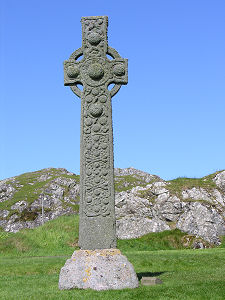 Mighty Bamburgh Castle, in use as a Fortress in King Oswald's Day |
Saint Oswald, also known as King Oswald of Northumbria, lived from 604 until 5 August 642 and was King of Northumbria from 634 until his death. He is credited with restoring Christianity to Northumbria by instigating and supporting the missionary efforts of Aidan of Lindisfarne. The wider picture in Scotland at the time is set out in our Historical Timeline.
Oswald was the son of Æthelfrith, King of Bernicia (effectively modern Northumberland and South-East Scotland). Æthelfrith also came to rule Deira (effectively modern Yorkshire) as part of an arrangement under which he married Oswald's mother, Acha, a member of the Deiran royal family. Oswald was born shortly afterwards, in 604. Æthelfrith was killed in 616 by King Raedwald of East Anglia during a battle that took place at the River Idle in modern Nottinghamhsire. Acha's brother (and Oswald's uncle) Edwin of Deira subsequently became king of Northumbria, and the 12-year-old Oswald and his siblings, including his sister Aebbe, who would later become St Aebbe, fled for safety to the Scottish kingdom of Dalriada. Oswald would spend the next 18 years in what is now Scotland and Ireland, where he converted to Christianity.
Edwin of Deira was killed in battle in 632 by Cadwallon ap Cadfan, the king of Gwynedd. Oswald's brother Eanfrith subsequently became king of Bernicia, before he too was killed by Cadwallon in 634. Oswald then rode south, probably with Scots and Pictish support, and defeated Cadwallon in battle at Heavenfield, near Hexham. It is said that before the battle, Oswald had a wooden cross erected which he asked his army to pray to. Despite leading the smaller army, Oswald defeated Cadwallon ap Cadfan, who was killed.
Following his victory, Oswald was crowned king of Northumbria, and governed a kingdom that extended down the whole east side of the country from the Firth of Forth in the north to the Humber Estuary (and possibly beyond) in the south. Oswald then invited monks from the monastery on Iona to help him convert his subjects to Christianity.
The mission was initially under the control of a bishop named Cormán, but his approach was seen as unsympathetic and he only succeeded in alienating those he was trying to convert. Cormán returned in failure to Iona in 635, and was replaced by the man who became known as Aidan of Lindisfarne. Aidan chose the island of Lindisfarne as his base, and founded a monastery there. He then set out, with his supporters, to walk the length and breadth of Northumbria. Over the years that followed he converted the Northumbrians though personal piety and the power of his example. Oswald strongly supported Aidan's work and, it is said (albeit by those trying to make a case for his sainthood) that he played an important role himself in setting a Christian example.
King Oswald of Northumbria was killed by Mercians at the Battle of Maserfield (near modern Oswestry) in 642. The spot where he was killed soon became associated with miracles, and he quickly came to be regarded as a saint. St Oswald's relics moved around a fair bit over the following centuries, often also being associated with miracles. It is said that his head eventually found a resting place in Durham Cathedral, while an arm made it as far as Peterborough Abbey. A number of churches in England and Scotland are named after St Oswald, as are the villages of Kirkoswald in Ayrshire, Kirkoswald in Cumbria, and Oswaldtwistle in Lancashire.

